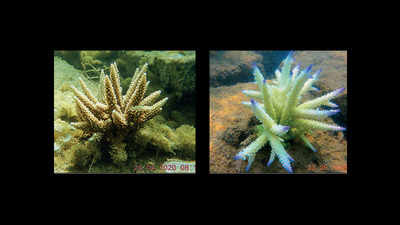- News
- City News
- chennai News
- Record-hot sea surface bleaches corals along Tamil Nadu coast
Trending
This story is from May 24, 2020
Record-hot sea surface bleaches corals along Tamil Nadu coast
After a record-high sea surface temperature observed in some pockets of Bay of Bengal triggered a change in the atmosphere and gave strength to cyclone Amphan that wreaked havoc in coastal Orissa and West Bengal, it is now posing threat to coral reefs, one of the most vulnerable marine ecosystem, near Tamil Nadu coast.

While corals in Gulf of Mannar were bleached 43% when observed in April (left), they were almost completely bleached when checked on Saturday due to record-high sea surface temperatures
CHENNAI: After a record-high sea surface temperature observed in some pockets of Bay of Bengal triggered a change in the atmosphere and gave strength to cyclone Amphan that wreaked havoc in coastal Orissa and West Bengal, it is now posing threat to coral reefs, one of the most vulnerable marine ecosystem, near Tamil Nadu coast.
An underwater survey conducted by researchers from National Centre for Coastal Research (NCCR) found that nearly 85% of the corals in Gulf of Mannar bleached between mid-April to mid-May after the sea surface temperatures touched a record 34Rs C.The bleaching was observed both in the natural habitat as well as restoration area in Manoli Islands, where polyps are planted on small concrete slabs. A few days before Amphan formed, a few weather buoys in the south and north Bay of Bengal recorded sea surface temperatures of 32-34Rs C . According to climatologists, one of the reasons behind the high seas surface temperatures in Bay of Bengal, observed probably for the first time ever, was due to global warming.
“The bleaching was observed up to 5m depth while those in 10m depth were not affected. We saw a similar bleaching event last year, but the temperatures were not this high, and bleaching was observed only in the month of May. This time, we saw 43% bleaching in April and it increased in May,” said an NCCR scientist involved in the survey. “In the 2019 event, corals recovered in August 2019 when the temperatures dropped. This time we have to wait and see,” he added.
Gulf of Mannar is home to 128 species like acropora and porites that were mapped through remote sensing by NCCR scientists between 2002 and 2005. The study team, which also mapped coral species in other locations in the Indian regions including Gulf of Kutch, Lakshadweep and Andaman and Nicobar Islands, is planning to survey their health status through another study. “We may soon conduct a survey in Lakshadweep,” a scientist said.
In Gulf of Mannar, unlike the global bleaching events recorded in 2016 and 2017 that resulted in 16% mortality of corals, NCCR scientists said the present event is due to a local phenomenon.
Climate scientist Roxy Mathew Koll from Indian Institute of Tropical Meteorology, Pune said Bay of Bengal has been warming over the last several years and is contributing to the drastic intensification of cyclones developing over the region as well as posing threat to the already vulnerable coral reef ecosystem. “Bay of Bengal has been rapidly and monotonously warming in the last several years and it is part of the global warming trend,” he said.
An underwater survey conducted by researchers from National Centre for Coastal Research (NCCR) found that nearly 85% of the corals in Gulf of Mannar bleached between mid-April to mid-May after the sea surface temperatures touched a record 34Rs C.The bleaching was observed both in the natural habitat as well as restoration area in Manoli Islands, where polyps are planted on small concrete slabs. A few days before Amphan formed, a few weather buoys in the south and north Bay of Bengal recorded sea surface temperatures of 32-34Rs C . According to climatologists, one of the reasons behind the high seas surface temperatures in Bay of Bengal, observed probably for the first time ever, was due to global warming.
“The bleaching was observed up to 5m depth while those in 10m depth were not affected. We saw a similar bleaching event last year, but the temperatures were not this high, and bleaching was observed only in the month of May. This time, we saw 43% bleaching in April and it increased in May,” said an NCCR scientist involved in the survey. “In the 2019 event, corals recovered in August 2019 when the temperatures dropped. This time we have to wait and see,” he added.
Gulf of Mannar is home to 128 species like acropora and porites that were mapped through remote sensing by NCCR scientists between 2002 and 2005. The study team, which also mapped coral species in other locations in the Indian regions including Gulf of Kutch, Lakshadweep and Andaman and Nicobar Islands, is planning to survey their health status through another study. “We may soon conduct a survey in Lakshadweep,” a scientist said.
Several factors like change in chemical composition, temperatures and carbon dioxide can affect corals. When the sea surface temperature rises, corals expel zooxanthellae, an algae that gives corals its colour, and turn white (bleaching). While corals survive such bleaching events, they die when they are exposed to extreme stress for a long time.
In Gulf of Mannar, unlike the global bleaching events recorded in 2016 and 2017 that resulted in 16% mortality of corals, NCCR scientists said the present event is due to a local phenomenon.
Climate scientist Roxy Mathew Koll from Indian Institute of Tropical Meteorology, Pune said Bay of Bengal has been warming over the last several years and is contributing to the drastic intensification of cyclones developing over the region as well as posing threat to the already vulnerable coral reef ecosystem. “Bay of Bengal has been rapidly and monotonously warming in the last several years and it is part of the global warming trend,” he said.
End of Article
FOLLOW US ON SOCIAL MEDIA










